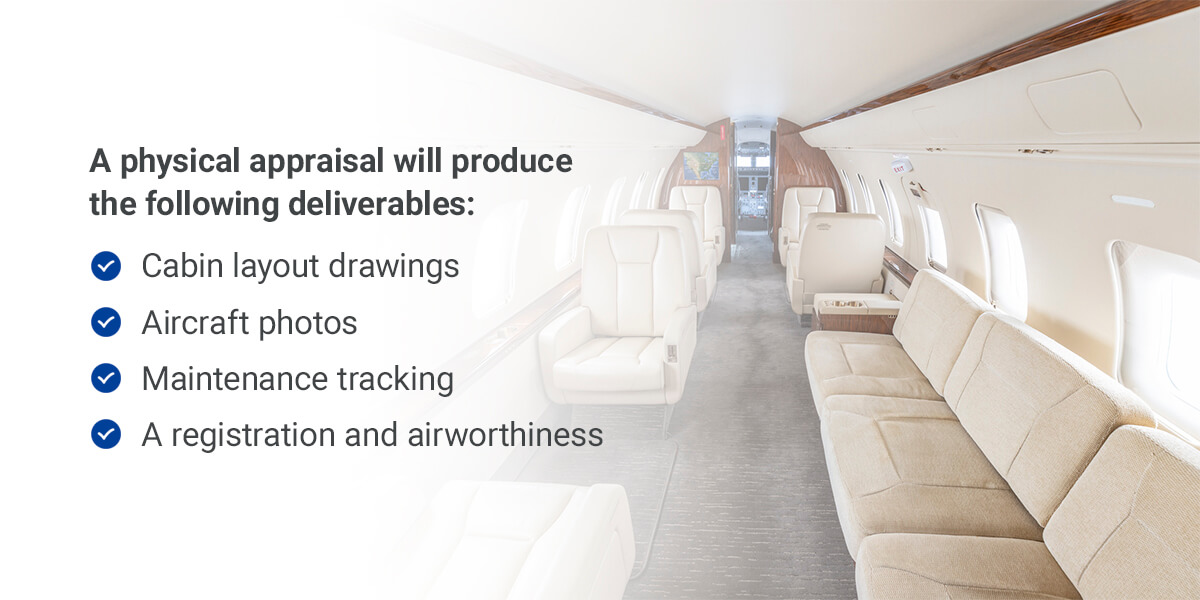Aircraft valuation helps owners, buyers and sellers determine the fair market value of their jet. Certified appraisers know how to determine the value of a plane accurately. Their valuations produce the most accurate appraisal possible, and a certified appraiser can effectively evaluate the elements that influence an aircraft’s true value.
What Is an Aircraft Appraisal?
An aircraft appraisal is an impartial, professional opinion of an aircraft’s value. Experts who understand the factors of the used aircraft market’s current behavior prepare appraisals based on analysis and experience. Certified aircraft appraisers provide valued opinions that can be justified and substantiated.
A person purchasing an aircraft uses an appraisal to understand its value. They can trust a professional aircraft appraiser’s opinion because it will be impartial and based on professional experience.
An appraisal lets a seller know their aircraft’s condition as well as its current fair market value so they can go into the sales process with confidence. An appraisal also documents the condition and value of an aircraft and supports a bank’s collateral position in an aircraft loan.
What Is the Purpose of an Appraisal?
An appraisal will help you determine an aircraft’s market value so you can list it or purchase it at an appropriate price that reflects the aircraft’s worth. An appraisal performed by a certified appraiser will ensure you have an accurate valuation to help you enter the sales and purchasing process confidently. An appraisal will help you avoid overpaying for an aircraft or selling it for less than it’s worth.
When Do You Conduct an Appraisal?
You should conduct an appraisal in any of the following situations:
- Purchasing a pre-owned aircraft
- Selling a share of your private jet or changing ownership
- Evaluating or changing an aircraft’s insurance coverage based on its worth
- Securing financing or asset management for tax purposes
- Refinancing your aircraft
Most leasing companies, banks, and insurance underwriters require an accurate valuation performed by a certified appraiser before they will approve financing. Appraisals often take a week to perform, depending on the aircraft’s complexity, so it’s best to schedule an appraisal as soon as you can to ensure the process is complete when you plan to buy, sell, or refinance your aircraft.
The 3 Types of Appraisals
There are three different appraisal options that offer various degrees of accuracy. Aircraft valuation methodology includes:
Pricing Digest Valuation
A pricing digest valuation analysis is based on published data in a Blue Book or a value reference (Vref). This appraisal type has the lowest cost, but it often provides general and stale information. Most people are satisfied with pricing digest valuation appraisals, but this approach is difficult to use when an aircraft features notable upgrades.
Additionally, pricing digest valuation appraisals cannot incorporate current aircraft supply and demand conditions, and these conditions can significantly impact a jet’s value. If an aircraft was produced in limited numbers, its demand will fluctuate, which means the pricing digest may indicate a significantly lower or higher price than the aircraft’s actual current value.
Desktop Appraisal
A desktop appraisal is a more accurate analysis that combines a pricing digest valuation with supply and demand conditions and other factors. This combination of factors produces a more comprehensive and accurate analysis of an aircraft’s value. When a certified appraiser performs a desktop appraisal, they can determine an aircraft’s value by analyzing:
- Recent prices
- The number of days an aircraft has been on the market
- Upgrades
- Logbooks
- Maintenance records
- The aircraft’s specifications
- Upcoming maintenance expenses
Physical Appraisal

A physical appraisal is a comprehensive, hands-on inspection and analysis of an aircraft’s value, and it is the most precise appraisal method. Physical appraisals are best for more unique or expensive aircraft. During a physical appraisal, the appraiser will inspect the engine, check logs, open panels, and check the entire aircraft to determine its current condition. A physical appraisal will produce the following deliverables:
- Cabin layout drawings
- Aircraft photos
- Maintenance tracking
- A registration and airworthiness certificate copy
What Happens During an Appraisal?
During an aircraft appraisal, the appraiser will collect all of the necessary information about the aircraft to determine its fair market value. They will thoroughly inspect the jet’s interior and exterior in a physical appraisal, check the maintenance history, and examine the aircraft’s logbooks.
The Elements of an Appraisal
Appraisers will look at the aircraft’s basic make and model configuration and compare the aircraft to similar models. If the aircraft’s indicators are more favorable than the basic configuration, the appraiser will add value. If its indicators are less favorable, the appraiser will subtract value.
The elements of an aircraft appraisal include:
Year, Make, and Model
Newer aircraft models will typically cost more than older models. For example, a 2016 aircraft model will have more value than a 2009 model. The make and model also affect a jet’s value. Appraisers will check if certain models have flight restrictions and regulations, such as avionics and noise abatements, that contribute to an aircraft’s value.
Interior and Exterior
Appraisers will inspect an aircraft’s interior and exterior elements such as paint, seating, and rugs. They will rate the exterior paint on a scale of 1 to 10, with 1 indicating no paint and 10 indicating that the paint looks new. They will also use this numerical scale for the interior. They will give a lower score for the aircraft’s interior if it has no interior elements or if there is significant wear and tear to the rugs and seating. The aircraft will receive a higher score if the interior smells and looks new.
Engine Time, Airframe Time, and Auxiliary Power Unit
Appraisers can measure an aircraft’s performance using cycles, landings, and total flight hours. If an aircraft has higher than average values for landings, cycles, and time, it will have less value. If it has below-average values for these elements, it will have more value. These variables also precipitate future maintenance procedures, which could increase or decrease the aircraft’s value.
Avionics
An aircraft’s avionics will vary depending on the aircraft model. Avionics include the following electronic systems:
- Navigation
- Communications
- Flight control
- Monitoring
- Weather systems
- Fuel systems
- Collision avoidance
- Display
An appraiser will compare the aircraft’s avionics to the basic model’s avionic configuration. An aircraft’s avionic values will increase or decrease its value, and some avionics are more beneficial than others. For example, an onboard internet connection will make an aircraft more valuable than one without an internet connection.
Airworthiness Directives
An aircraft’s airworthiness directives should be up-to-date and compliant. If airworthiness directives do not meet the necessary standards to fly the aircraft, the appraiser will have to factor the cost to restore airworthy conditions into the appraisal.
Aircraft Logbooks
Appraisers will check the aircraft’s logbook to make sure it is complete and original. An incomplete logbook can decrease an aircraft’s value because it could hide past structural damage. An incomplete logbook can also make it more challenging for a new owner to resell the aircraft in the future.
Geographical and International Location
An aircraft’s geographical location can contribute to its condition because different climates can cause damage over time. Consistent operations in snow, ice, and cold weather put more demand on an aircraft, while locations with humid or salty air can cause corrosion. Sand can damage the engine if an aircraft is in a desert location, which can cause future issues.
It’s also important to consider an aircraft’s international location. A jet in a foreign country could potentially have a logbook in another language or have past maintenance and inspections from unrecognized facilities.
Aircraft Damage
Appraisers will evaluate an aircraft’s damage on a case-by-case basis. Any type of damage will make a jet less valuable than one of the same model with no damage, but minimal issues are not as detrimental as severe concerns.
Significant damage can affect the aircraft’s airworthiness and require expensive repairs, which an appraiser will reflect in the final value. Regular maintenance can prevent damage and keep your aircraft in good condition.
 Private Jet Brokerage Services from Latitude 33 Aviation
Private Jet Brokerage Services from Latitude 33 Aviation
Purchase or sell a quality private jet with confidence at Latitude 33 Aviation. We will help you determine an aircraft’s fair market value with accuracy so you can purchase a new aircraft or sell your current one.
At Latitude 33 Aviation, we conduct accurate appraisals with extensive expertise and honesty. We will determine the most beneficial and fair aircraft price based on up-to-the-minute data on market conditions. Contact Latitude 33 Aviation or call 1-800-840-0310 to request aircraft brokerage services.





Comments are closed.